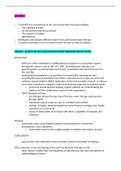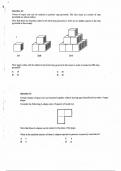Lecture 1
1. The Dutch School System
a. Regular:
i. Primary Schools
ii. Secondary Education and pre-vocational secondary education
b. Special needs primary schools- No DSM diagnosis, learning problems, light behavioral
problems
c. Special needs schools-DSM Diagnosis, both primary and secondary schools
i. Cluster 3&4 within Regular School cooperation
ii. Cluster 1&2 separate
iii. Cluster 1: Visually handicapped
iv. Cluster 2: Auditory and communication handicaps; Autism Spectrum
Disability (ASS) with primary language problems
v. Cluster 3: Physical, mental and multiple handicaps
vi. Cluster 4: Children with serious behavioral problems
2. Passendonderwijs= Dutch Inclusive education
a. 1 child, 1 family, 1 plan
b. Response to intervention: First: A strong base => Support when needed => Special if
required
c. Support levels:
i. Basic support within school in own group(Level 1)
ii. Additional support within school together with special needs school (Level 2)
iii. Additional specialist support in special needs school (Level 3)
3. What is Youth Health Care Psychology and School Psychology?
a. School psychology:
i. Work in school settings or at the intersection between youth care and
education
ii. Focus on functioning in school context
iii. Prevention: training groups in school e.g. cognitive behavior therapy, give
policy advice school directors
iv. Psychological training: reducing impact of individual psychopathology,
training teachers, remedial teachers, parents
v. Knowledge: normal development, deviant development, psychopathology
and intervention techniques, (Youth)care system
vi. No DSM diagnosis, yet diagnosis health care Dyslexia
b. Youth health Care Psychology (GGZ)
i. Postmaster focus Children and Youth: 65% courses Children and Youth and
35% Adults and Elderly
ii. Working in youth care setting
iii. Diagnosis, assesment of health care need, Psychological treatment and
psychological training
iv. Knowledge: normal development, deviant development, psychopathology
and intervention techniques, (youth) care system, school system
4. Diagnosis: Important considerations
a. Equifinality- several possible pathways may produce the same outcome =>
differential diagnosis
, b. Multifinality- similar risks may produce different outcomes depending on individual
differences (Brenda this lecture)
c. Multimodal/multimethod- variety of informants (parents, teachers, child, peers) and
procedures (interviews, questionnaires, standardized tests)
d. DSM as a categorical system
e. Clear-cut categories are used and needed in Health Service!
f. Pathology is rarely 1 or 0: it is more often a pain in your leg rather than a broken leg
g. ADHD, Eating Disorders, Dyslexia, Anxiety, Addiction, Autism: far on a continuum of
normal development
h. Pathology may change with time
i. Comorbidity: what is the prime cause, 1,2 or 1 and 2?
j. Categories are needed for policies
5. Models for deviant development: Ecological model and Transactional model
a.
Bioecological model
b. Transactional models :HGD
c. Transactional model: the ongoing and interactive nature of developmental change
between the child and the environment
d. The development of the child is a product of the continuous dynamic interactions of
the child and the experience provided by his or her social settings. What is core to
the transactional model is the analytic emphasis placed on the bidirectional,
interdependent effects of the child and environment.
e. Action oriented assessment/diagnosis- a decision process in which developmental
and learning problems are distinguished, analyzed, explanations for problems are
sought and solutions are advised; goal: advice, not diagnosis
, 6. Which behavior is deviant and why does it develop?
a. When is problematic behavior deviant: 4 D’s
i. Deviance from the norm
ii. Distress
iii. Dysfunctional
iv. Dangerous
v. (Duration)
7. Knowing about typical problems in developmental phases
8. Explaining and comparing the diathesis stress model and differential susceptibility model
a. Diathesis stress model
i. Diathesis: predisposition
ii. Stress: circumstances
iii. diathesis + stress = outcome
1. The Dutch School System
a. Regular:
i. Primary Schools
ii. Secondary Education and pre-vocational secondary education
b. Special needs primary schools- No DSM diagnosis, learning problems, light behavioral
problems
c. Special needs schools-DSM Diagnosis, both primary and secondary schools
i. Cluster 3&4 within Regular School cooperation
ii. Cluster 1&2 separate
iii. Cluster 1: Visually handicapped
iv. Cluster 2: Auditory and communication handicaps; Autism Spectrum
Disability (ASS) with primary language problems
v. Cluster 3: Physical, mental and multiple handicaps
vi. Cluster 4: Children with serious behavioral problems
2. Passendonderwijs= Dutch Inclusive education
a. 1 child, 1 family, 1 plan
b. Response to intervention: First: A strong base => Support when needed => Special if
required
c. Support levels:
i. Basic support within school in own group(Level 1)
ii. Additional support within school together with special needs school (Level 2)
iii. Additional specialist support in special needs school (Level 3)
3. What is Youth Health Care Psychology and School Psychology?
a. School psychology:
i. Work in school settings or at the intersection between youth care and
education
ii. Focus on functioning in school context
iii. Prevention: training groups in school e.g. cognitive behavior therapy, give
policy advice school directors
iv. Psychological training: reducing impact of individual psychopathology,
training teachers, remedial teachers, parents
v. Knowledge: normal development, deviant development, psychopathology
and intervention techniques, (Youth)care system
vi. No DSM diagnosis, yet diagnosis health care Dyslexia
b. Youth health Care Psychology (GGZ)
i. Postmaster focus Children and Youth: 65% courses Children and Youth and
35% Adults and Elderly
ii. Working in youth care setting
iii. Diagnosis, assesment of health care need, Psychological treatment and
psychological training
iv. Knowledge: normal development, deviant development, psychopathology
and intervention techniques, (youth) care system, school system
4. Diagnosis: Important considerations
a. Equifinality- several possible pathways may produce the same outcome =>
differential diagnosis
, b. Multifinality- similar risks may produce different outcomes depending on individual
differences (Brenda this lecture)
c. Multimodal/multimethod- variety of informants (parents, teachers, child, peers) and
procedures (interviews, questionnaires, standardized tests)
d. DSM as a categorical system
e. Clear-cut categories are used and needed in Health Service!
f. Pathology is rarely 1 or 0: it is more often a pain in your leg rather than a broken leg
g. ADHD, Eating Disorders, Dyslexia, Anxiety, Addiction, Autism: far on a continuum of
normal development
h. Pathology may change with time
i. Comorbidity: what is the prime cause, 1,2 or 1 and 2?
j. Categories are needed for policies
5. Models for deviant development: Ecological model and Transactional model
a.
Bioecological model
b. Transactional models :HGD
c. Transactional model: the ongoing and interactive nature of developmental change
between the child and the environment
d. The development of the child is a product of the continuous dynamic interactions of
the child and the experience provided by his or her social settings. What is core to
the transactional model is the analytic emphasis placed on the bidirectional,
interdependent effects of the child and environment.
e. Action oriented assessment/diagnosis- a decision process in which developmental
and learning problems are distinguished, analyzed, explanations for problems are
sought and solutions are advised; goal: advice, not diagnosis
, 6. Which behavior is deviant and why does it develop?
a. When is problematic behavior deviant: 4 D’s
i. Deviance from the norm
ii. Distress
iii. Dysfunctional
iv. Dangerous
v. (Duration)
7. Knowing about typical problems in developmental phases
8. Explaining and comparing the diathesis stress model and differential susceptibility model
a. Diathesis stress model
i. Diathesis: predisposition
ii. Stress: circumstances
iii. diathesis + stress = outcome





